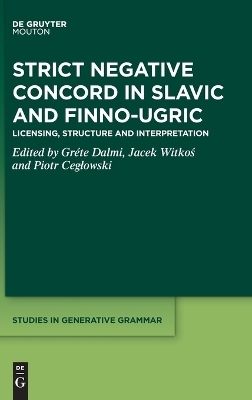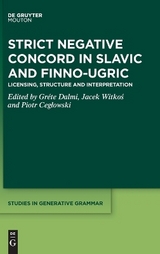Strict Negative Concord in Slavic and Finno-Ugric
Licensing, Structure and Interpretation
Seiten
2024
de Gruyter Mouton (Verlag)
978-3-11-075479-7 (ISBN)
de Gruyter Mouton (Verlag)
978-3-11-075479-7 (ISBN)
The architecture of the human language faculty has been one of the main foci of the linguistic research of the last half century. This branch of linguistics, broadly known as Generative Grammar, is concerned with the formulation of explanatory formal accounts of linguistic phenomena with the ulterior goal of gaining insight into the properties of the 'language organ'. The series comprises high quality monographs and collected volumes that address such issues. The topics in this series range from phonology to semantics, from syntax to information structure, from mathematical linguistics to studies of the lexicon.
Expressing negation is a universal property of all human languages. There is considerable variation, however, in the exact ways negation materializes cross-linguistically. Strict Negative Concord differs both from the Negative Polarity Item strategy and the Asymmetric Negative Concord strategy in that the sentence becomes negative only if the sentence negator is overtly expressed in it, irrespective of how many negative expressions are used. The central aim of this book is to describe Strict Negative Concord in some Slavic and Finno-Ugric languages. In particular, the volume gives an insight into the forms Strict Negative Concord manifests itself in Russian, Polish, Czech, Slovenian (Slavic), Finnish, Hungarian, Mari (Finno-Ugric) and the closely related Selkup (Samoyedic) to a wide linguistic community. It aims to create a platform for comparison with similar phenomena in well-described European languages.
Expressing negation is a universal property of all human languages. There is considerable variation, however, in the exact ways negation materializes cross-linguistically. Strict Negative Concord differs both from the Negative Polarity Item strategy and the Asymmetric Negative Concord strategy in that the sentence becomes negative only if the sentence negator is overtly expressed in it, irrespective of how many negative expressions are used. The central aim of this book is to describe Strict Negative Concord in some Slavic and Finno-Ugric languages. In particular, the volume gives an insight into the forms Strict Negative Concord manifests itself in Russian, Polish, Czech, Slovenian (Slavic), Finnish, Hungarian, Mari (Finno-Ugric) and the closely related Selkup (Samoyedic) to a wide linguistic community. It aims to create a platform for comparison with similar phenomena in well-described European languages.
Gréte Dalmi, Independent Researcher, Budapest, Hungary; Jacek Witkos and Piotr Ceglowski, Adam Mickiewicz University, Poznan, Poland.
| Erscheinungsdatum | 11.05.2024 |
|---|---|
| Reihe/Serie | Studies in Generative Grammar [SGG] ; 148 |
| Zusatzinfo | 5 b/w and 4 col. ill., 15 b/w tbl. |
| Verlagsort | Basel/Berlin/Boston |
| Sprache | englisch |
| Maße | 155 x 230 mm |
| Gewicht | 592 g |
| Themenwelt | Geisteswissenschaften ► Sprach- / Literaturwissenschaft ► Anglistik / Amerikanistik |
| Geisteswissenschaften ► Sprach- / Literaturwissenschaft ► Sprachwissenschaft | |
| Schlagworte | Finno-Ugric • Licensing • Locality Conditions • Slavische Sprachen • Strict Negative Concord • Strict Negative Concord, Licensing, Locality Conditions • Syntax |
| ISBN-10 | 3-11-075479-7 / 3110754797 |
| ISBN-13 | 978-3-11-075479-7 / 9783110754797 |
| Zustand | Neuware |
| Haben Sie eine Frage zum Produkt? |
Mehr entdecken
aus dem Bereich
aus dem Bereich
Poetik eines sozialen Urteils
Buch | Hardcover (2023)
De Gruyter (Verlag)
59,95 €
Buch | Softcover (2024)
belleville (Verlag)
20,00 €




